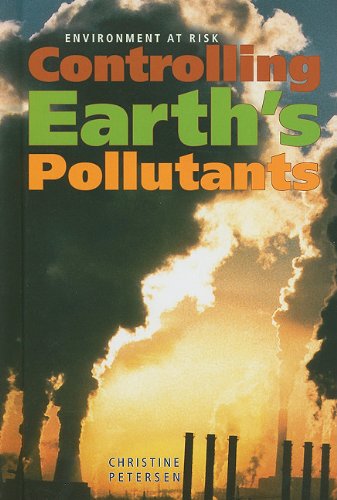Controlling Earth s Pollutants 1st Edition by Christine Petersen ISBN 0761440054 9780761440055 by Christine Petersen 0761440054 instant download after payment.
Controlling Earth s Pollutants 1st Edition by Christine Petersen - Ebook PDF Instant Download/Delivery: 0761440054, 9780761440055
Full download Controlling Earth s Pollutants 1st Edition after payment

Product details:
ISBN 10: 0761440054
ISBN 13: 9780761440055
Author: Christine Petersen
Controlling Earth s Pollutants 1st Table of contents:
Part I: Understanding Pollutants and Their Impact
Chapter 1: The Nature of Pollutants
- Defining Pollutants: What Makes a Substance Harmful?
- Classification of Pollutants:
- Biodegradable vs. Non-Biodegradable
- Primary vs. Secondary Pollutants
- Quantitative vs. Qualitative Pollutants
- Sources of Pollution: Natural and Anthropogenic
Chapter 2: Types of Environmental Pollution and Their Effects
- Air Pollution:
- Key Pollutants (Particulate Matter, NOx, SOx, CO, VOCs, Ozone)
- Sources (Industrial, Transport, Agriculture, Residential)
- Impacts on Human Health, Ecosystems, and Climate
- Water Pollution:
- Types of Water Pollutants (Chemicals, Nutrients, Pathogens, Plastics)
- Sources (Industrial Discharge, Agricultural Runoff, Urban Wastewater)
- Impacts on Aquatic Life, Drinking Water, and Human Health
- Soil Pollution:
- Contaminants (Heavy Metals, Pesticides, Industrial Waste)
- Sources (Improper Waste Disposal, Industrial Activities, Agriculture)
- Impacts on Soil Fertility, Food Safety, and Ecosystems
- Noise Pollution:
- Sources (Traffic, Industry, Construction)
- Impacts on Human Health and Wildlife
- Thermal Pollution:
- Sources (Power Plants, Industrial Processes)
- Impacts on Aquatic Ecosystems
- Light Pollution:
- Sources (Urban Lighting)
- Impacts on Wildlife and Astronomical Observation
- Nuclear/Radioactive Pollution:
- Sources (Nuclear Power, Medical Waste, Weapons)
- Impacts on Health and Environment
Part II: Strategies and Technologies for Pollution Control
Chapter 3: Principles of Pollution Control and Prevention
- The Pollution Control Hierarchy: Avoid, Reduce, Reuse, Recycle, Treat, Dispose
- The Shift to Pollution Prevention (P2)
- Integrated Multimedia Solutions
- The Role of Science and Engineering
Chapter 4: Air Pollution Control
- Source Reduction Strategies
- End-of-Pipe Technologies (e.g., Scrubbers, Electrostatic Precipitators, Catalytic Converters)
- Fuel Quality and Energy Efficiency Improvements
- Monitoring and Measurement of Air Quality
Chapter 5: Water Pollution Control
- Wastewater Treatment Processes (Primary, Secondary, Tertiary)
- Industrial Wastewater Treatment
- Addressing Nonpoint Source Pollution (e.g., Agricultural Best Management Practices)
- Protecting Groundwater and Marine Environments
Chapter 6: Waste Management and Soil Remediation
- Solid Waste Management: Reduction, Reuse, Recycling, Composting
- Landfilling and Incineration (with pollution controls)
- Hazardous Waste Management
- Soil Remediation Techniques (e.g., Bioremediation, Phytoremediation)
Chapter 7: Emerging Pollutants and Future Challenges
- Persistent Organic Pollutants (POPs)
- Microplastics
- Pharmaceuticals and Personal Care Products (PPCPs)
- Nanomaterials
- Climate Change as a Pollution Amplifier
Part III: Policy, Economics, and Global Cooperation
Chapter 8: Environmental Law and Regulations
- National Environmental Policies (e.g., Clean Air Act, Clean Water Act)
- Enforcement and Compliance
- The Role of Environmental Agencies (e.g., EPA)
Chapter 9: International Cooperation and Global Governance
- Transboundary Pollution
- International Treaties and Conventions (e.g., Stockholm Convention on POPs)
- Role of International Organizations (UNEP, WHO)
- Global Challenges and Shared Responsibilities
Chapter 10: Economic Aspects of Pollution Control
- The Costs of Pollution (Health, Environmental Damage, Economic Loss)
- The Economics of Pollution Control: Costs and Benefits
- Economic Instruments (Taxes, Subsidies, Cap-and-Trade)
- Green Technologies and Sustainable Development
Chapter 11: Community Action and Individual Responsibility
- Public Awareness and Education
- Citizen Science and Advocacy
- Sustainable Consumption and Lifestyle Choices
- The Power of Collective Action
Conclusion: Towards a Cleaner Earth
- Recap of Key Concepts
- The Interconnectedness of Environmental Issues
- The Path Forward: Innovation, Policy, and Individ
People also search for Controlling Earth s Pollutants 1st:
controlling earth's pollutants
controlling pollution
earth pollutants
controlling release of pollutant
a pollutant released on one continent is found concentrated
Tags: Christine Petersen, Controlling, Pollutants



